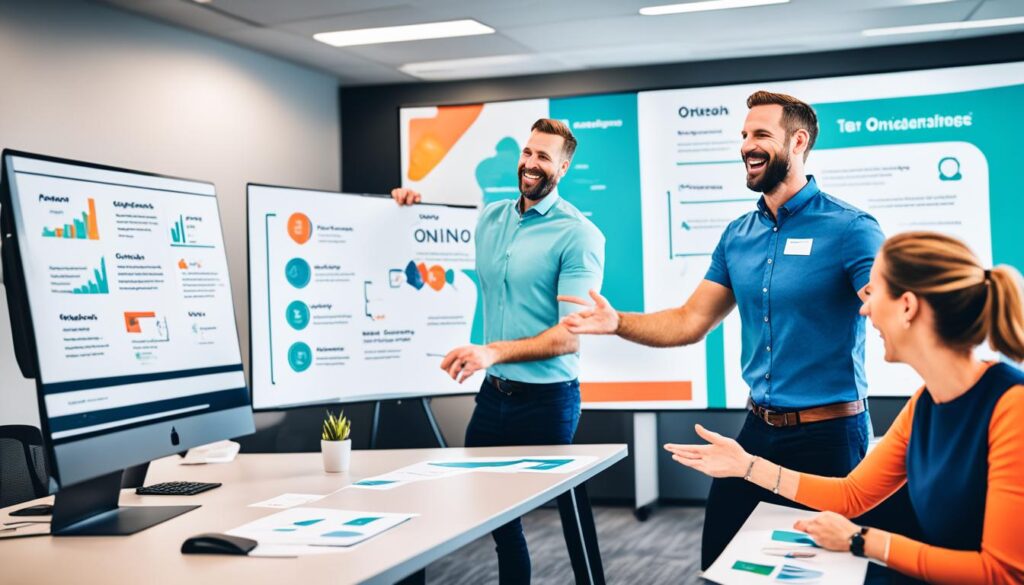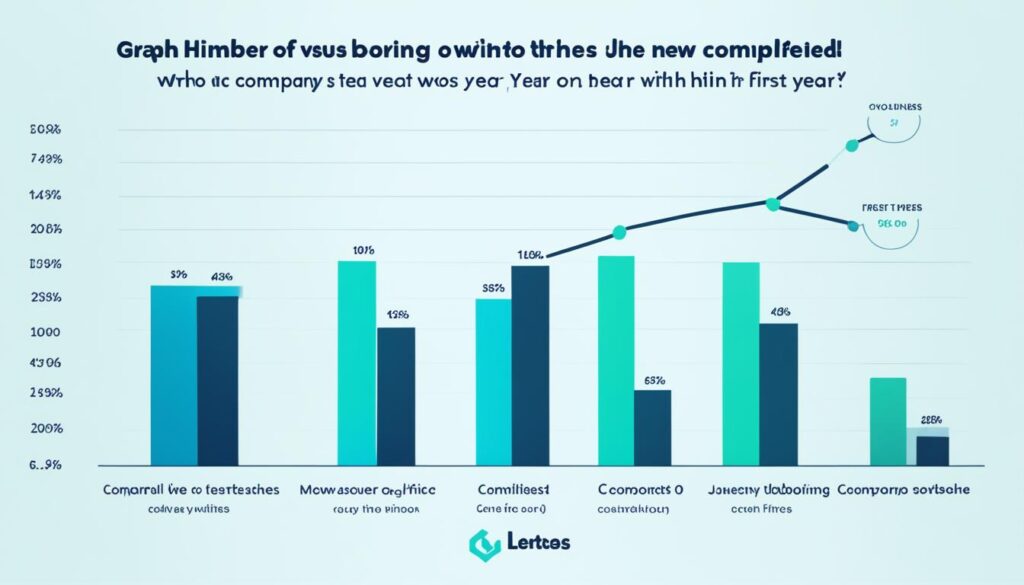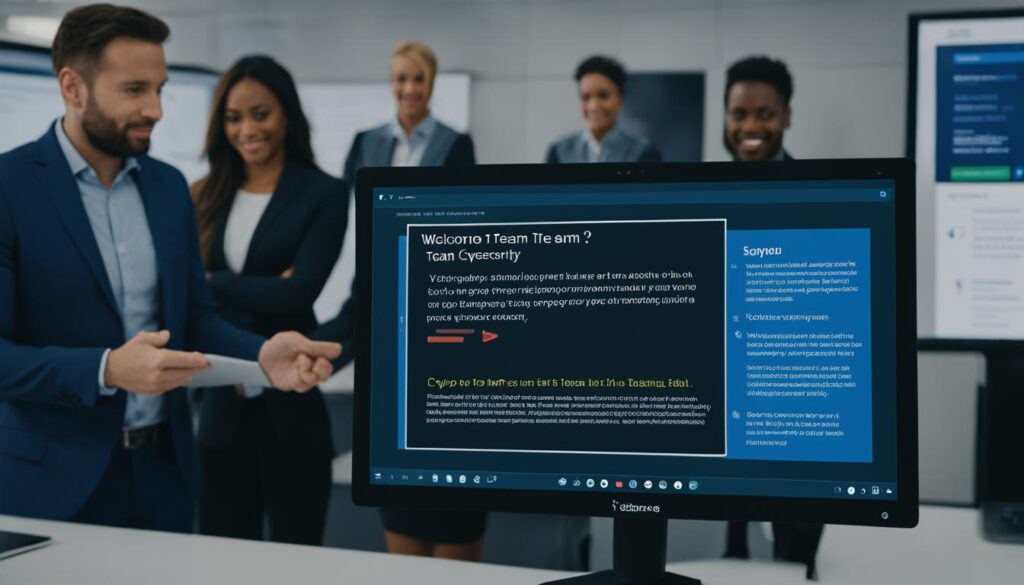Did you know that 20% of employee turnover happens within the first 45 days of employment? This stat shows how important a good employee onboarding program is. It ensures new hires mix well into the company and start being useful fast.
New employees begin their journey into your company with a process called onboarding. It should last about a year. Those first days and months are key to keeping them and making them happy. A great onboarding plan focuses on when to start, how long it lasts, and what to include.
This guide will show you how to make an engaging culture intro, explain benefits clearly, give crucial training, and set workplace rules. You’ll also learn how to introduce them to your team and share your company’s goals. Investing in an in-depth onboarding presentation helps your new team members succeed long-term and feel at home in your company.
Key Takeaways
- Employee turnover in the first 45 days can be reduced through effective onboarding
- Onboarding should be a strategic, year-long process
- Key considerations include timing, duration, and content of the onboarding presentation
- A comprehensive onboarding presentation covers company culture, benefits, training, policies, team intros, and mission
- Investing in onboarding sets new hires up for success and fosters a sense of belonging
Understanding the Importance of Employee Onboarding
Employee onboarding is key to how a new hire will feel about joining a team. It’s about making them feel part of the company from day one. By giving them the right tools and info, they can start strong and be productive. This can really help keep them around, make them happy, and get them fully involved in their work. Employee retention, joy in their job, and how much they get involved all see big boosts.
Defining Employee Onboarding
Employee onboarding means more than just first-day paperwork. It’s about a whole strategy to help new folks see their role, the company goals, and their place in the team. It helps them understand what they do, why they do it, and feel like a part of the mission. Here’s what a good onboarding program does:
- It shows new hires what the company values.
- Explains clearly what their job is and what they should do.
- Helps them learn what they need to know to do their jobs well.
- It makes meeting coworkers and managers easy and comfortable.
- Smooths the way for them to get used to their new workplace.
But, sadly, only a few workers think their onboarding was done well. Likewise, not many of the brand-new employees feel fully ready to shine in their roles. This shows there’s a lot of room to do better.
Benefits of a Well-Structured Onboarding Program
A great onboarding program is a win-win for everyone. The company and the new team member both see good results. Here’s what everyone gets out of it:
- They become fully productive in their new roles quicker.
- They’re happier with their jobs and more likely to stay.
- They feel more connected and committed to their work.
- The whole team understands the company’s goals and values better.
Studies show, a good onboarding program really makes a difference. It ties to how well the company does and how happy and committed the employees are. For the best results, the onboarding should last several months. It should answer key questions all along the way to ensure long-term success.
To get these benefits, companies need to do certain things. Like, match new hires with someone to guide them, check in often, and keep teaching them. By putting these practices in place, companies show they care about their new people. This leads to a happier, more involved, and hard-working team.
Key Components of an Effective Employee Onboarding Presentation
Making a good onboarding presentation is vital for new employee success. It introduces them to your company’s culture, policies, and benefits. A great onboarding presentation saves time and reduces confusion for everyone involved.
Company Overview and Culture
Start by talking about your company’s history, mission, vision, and values. This shares the organization’s purpose and guiding principles. It also tells about your company’s growth and what makes your culture unique. This gets new employees excited and connected to your company’s mission from their first day.
HR Policies and Procedures
Then, go through the must-know HR policies and procedures. This includes things like:
- Timekeeping and attendance
- Dress code
- Workplace safety
- Code of conduct
- Performance evaluations
Explaining these rules clearly helps new hires settle in without stress.
Benefits and Compensation
Detail your company’s benefits, from health plans to time off. Also, explain how the pay works. This transparency shows your care for employees’ health and wealth.
Training and Development Opportunities
Share the training and development chances, like:
- On-the-job training
- Workshops and seminars
- Mentoring programs
- Career growth paths
Focusing on development tells new hires they have a future here. It shows you value their growth and what they offer your company.
In closing, a good onboarding presentation should talk about your company’s culture, HR rules, benefits and pay, and growth opportunities. Covering these points helps new hires start off right. It makes them feel welcome and ready to help your company reach its goals.
Crafting an Engaging Employee Onboarding Presentation
To make a great onboarding presentation for new hires, concentrate on presentation design and adding multimedia. Use attractive slides, images, videos, and infographics to communicate important points. People remember things better when they see them visually. So, it’s key to use lots of visuals in your presentation.
Telling stories can really make your presentation stick. Share real examples and stories that show what your company is about. This way, new hires can feel a personal connection and see how they fit into the big picture.
Add fun stuff to really pull people in, like:
- Quizzes to test knowledge and help with learning
- Polls to get instant feedback and make everyone participate
- Team activities to build bonds and encourage working together
When you organize your presentation, make it flow naturally. Start with a warm welcome and intro. Then, talk about the company’s past, its goals and values. After that, touch on important HR stuff and what new employees can expect. Keep it brief and straightforward to avoid confusing them.
Using presentation templates can save you a lot of time and keep things uniform. Pick a template that matches your brand and onboarding style. This lets you focus on making a great, tailored onboarding experience for new team members.
Best Practices for Delivering an Employee Onboarding Presentation
When giving an onboarding presentation, remember a few key steps. Recent studies show, structured onboarding presentations help a lot. Companies that use them see 54% more productivity in new hires and 50% less people leaving. To really help your new hires, make your onboarding experience interact and engaging.
Creating an Interactive Experience
Interactivity is crucial for a good onboarding presentation. Companies agree, over 90% report better engagement when they use visuals like images and graphs. Adding in activities, discussions, or role plays makes your presentation stand out. It also helps new joins feel part of the team faster.

Encouraging Questions and Feedback
It’s really important to welcome questions and feedback. Did you know, companies that have Q&A sessions see better satisfaction from their employees? It’s a fact. Always keep it clear that questions are fine at any point. And make sure there’s time set aside just for them at the end. This helps clear up any confusion and shows where you can improve.
Following Up After the Presentation
The onboarding process doesn’t stop with the presentation. Ongoing support is key. Assigning a mentor or a buddy helps a lot, as does checking in regularly. This way, new hires really get settled in and become productive team members sooner.
By following these best practices, new employees will feel welcome and ready to contribute. Make sure they have the tools and support needed to do well in your company.
Adapting Your Employee Onboarding Presentation for Remote Teams
Remote onboarding is now a big part of how companies welcome new hires. It’s important to make your onboarding engaging and useful in a remote setup. With the right tools and methods, you can make onboarding smooth and rewarding for new team members.
Utilizing Virtual Presentation Tools
For a great virtual onboarding, use tools like Zoom, Microsoft Teams, or Google Meet. These have cool features that make presentations interactive. They include:
- Screen sharing: Show your slides, videos, or content to everyone at once.
- Virtual whiteboards: Work together on ideas, draw, or get feedback live.
- Breakout rooms: Have small group talks, team games, or practice scenarios.
- Polls and quizzes: Test knowledge with fun quizzes and get opinions with polls.
These tools can turn your presentation into a fun and engaging experience.
Fostering Connection in a Remote Setting
Creating a feeling of belonging is vital, especially when working from home. To make your team feel connected and engaged, try these ideas:
- Fun virtual team activities: Start with group activities that get your team chatting, like quizzes or virtual scavenger hunts.
- Introductions: Let each new hire share about themselves. It makes the team feel friendlier and more open.
- Mentor or buddy system: Pair up new hires with someone who can guide and support them. This person can be a mentor or a friend.
- Regular Video Chats: Keep up with team members regularly. This helps spot and solve any problems early and keeps everyone feeling connected.
Working on building connections from the start, you make sure your team knows they’re part of something special.
Measuring the Success of Your Employee Onboarding Presentation
Making sure your employee onboarding works well is key to helping new hires succeed. You can do this by checking onboarding success and hearing what employees say. This info lets you make your onboarding better for new team members.

Setting Key Performance Indicators (KPIs)
To see how good your onboarding is, create goals that match what your company wants. There are a few common goals for onboarding:
- Time-to-productivity: Figure out how quickly new hires get to work fully.
- New hire retention rates: Watch how many new people stick with the company after a set time, like 90 days or a year.
- Employee satisfaction scores: Ask newbies how happy they are with onboarding and their job steering.’
Keep an eye on these goals to spot trends. Then, you can change your onboarding to do better.
Gathering Employee Feedback
Getting feedback from new hires is also vital. It shows how well your onboarding is working. Here are some ways to do it:
- Do surveys right after the onboarding, then again after 30 and 90 days.
- Have sit-down talks with new hires to get their thoughts.
- Make a place where new hires feel safe sharing their ideas and concerns.
Using this feedback helps you find what’s good and what needs work. Then, you can fix your onboarding to make everyone happier. This boosts satisfaction, keeps more employees, and gets more from your onboarding investment.
Continuously Improving Your Employee Onboarding Presentation
Creating a great onboarding presentation takes work, and you should always be making it better. Your company will change and grow. So, you need to keep your onboarding program up to date with the latest tips, tools, and trends. This keeps your presentation fresh, interesting, and in line with your company’s mission.
Listening to what new employees say is key to improve your onboarding. Employee feedback helps you fix problems and make the whole process better. You can get this feedback through surveys, interviews, or focus groups. Doing this shows you what you’re doing right and where you can do better.
To lead in onboarding innovation, you must keep up with new ideas and techniques. Go to conferences, connect with other professionals, and read industry news. By updating your onboarding based on what you learn, your company will stand out in attracting and keeping the best people.
FAQ
What is employee onboarding?
How long should an employee onboarding program last?
What are the benefits of a well-structured onboarding program?
What should an effective employee onboarding presentation cover?
How can I create an engaging employee onboarding presentation?
What are some best practices for delivering an employee onboarding presentation?
How can I adapt my employee onboarding presentation for remote teams?
How can I measure the success of my employee onboarding presentation?
How can I continuously improve my employee onboarding presentation?
Author
-

Michael Chen's expertise lies in employee onboarding and training development. His methods have transformed new hire experiences, boosting engagement and long-term retention.
View all posts



